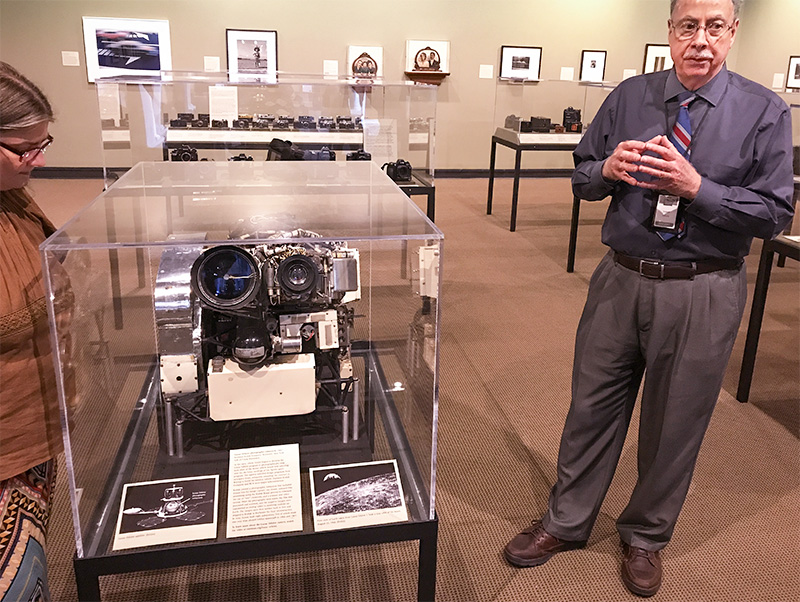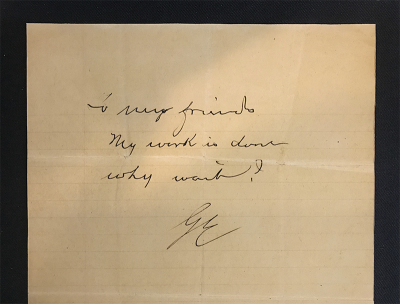 Volunteer docent and photo-history expert Jim Ulrich next to the Museum's lunar module camera in the History of Photography Gallery at the George Eastman Museum in Rochester, New York
Volunteer docent and photo-history expert Jim Ulrich next to the Museum's lunar module camera in the History of Photography Gallery at the George Eastman Museum in Rochester, New York
I had a red-letter weekend this past weekend. I had a date on Saturday (I felt a bit like Mrs. Hughes in "Downton Abbey": "I'm astonished that at my age..."), which was a lot of fun. I drove to Rochester—her backyard—and we went to the George Eastman Museum (GEM)—a little patch of my territory. She knew her way around Rochester but not the Museum, and I knew my way around the Museum but not Rochester. So we complemented each other in that regard like Jack Spratt and his missus.
The GEM cannot quite decide what its name should be. I grew up with it as "The George Eastman House," or GEH, which is how I still think of it. I can't parse its naming history for you, but at some point its full name was "George Eastman House International Museum of Photography and Film."
The genteel facade facing East Avenue in Rochester might make you think it's some sort of quaint decaying house museum with just a bunch of some dead guy's random old things lying about. Don't be fooled. The sprawling mansion comprises a whopping 35,000 square feet and contains vast underground vaults and a 500-seat theater (which shows classic movies among other things). And even that facade is a fooler. It's (appropriately) in the Georgian Revival style, designed by the famous architectural firm of McKim, Mead & White, but George E. was more than a bit of a nut—the whole mansion is constructed like a massive bunker, with walls of 14-inch-thick reinforced concrete. Even the roof is thick concrete underneath its demure shingles. Altogether, including George's eccentric renovations, the house cost more to build than the magnificent main building of the National Gallery on the Mall in Washington D.C.
And of course the photography collection is one of the world's best, with more than 14,000 photographers represented and numberless treasures. I think our tourguide said there are more than 450,000 pieces in the collection (films, photographs, objects, and ephemera), although with my innumeracy affliction you should please take that figure as provisional.
Pilgrimage
We were looking at the strange documentary work of objects by Robert Cumming, which is full of humor and at the same time emotionally barren, an odd combination (and not particularly date-friendly), when we were buttonholed by an affable docent named Jim Ulrich who was doing a sweep of the galleries rounding up people for his lecture on the history of photography. In the history gallery they were showing examples of Mexican photography, and Jim warmed to the Daguerreian era, which was fun. I will say that the GEM does a better job than any museum I know of showing equipment along with photographs—the cameras in the little history of photography room were awesome. Just the lineup of Leica rangefinders from first to latest was probably worth well into six figures, if not seven.
Later we met up with Jim again in the house, and he regaled us with more stories and even played the massive pipe organ for us. The pipe organ that serenaded George for an hour as he ate breakfast every morning was destroyed by fire in 1949, but the current replacement is the largest residential pipe organ in the world. Surround-sound, too!
 George Eastman's famous suicide note under glass in the children's
George Eastman's famous suicide note under glass in the children's
classroom that used to be his bedroom. "To my friends /
my work is done / why wait? / GE."
Can anyone recommend a good biography of George Eastman? I get more curious about him every time I visit the GEM.
Long story short, the GEM is a gem, and worthy of a pilgrimage at some point in your life. Come in the temperate months when you can see the gardens and grounds, and check that the show on view at the time you'll come is something you want to see. It's a lot more than just an old mansion—it's a major photography museum on par with the best in the world.
As if that weren't good enough for one weekend, on Sunday an old college buddy from Dartmouth was in the area with his wife and several members of his far-flung, charming, sociable family—Scott was definitely one of the cool kids in school—and they invited me to join them for dinner at one of the best winery restaurants in the area, called Veraisons. We had a great time.
Despite all the activities on my date on Saturday, I do have to say that the best part of it was sitting in the near-deserted café for an hour and a half, just the two of us, chatting.
Oh, and one more thing—Jim Ulrich told me that "ordinary people"—that would be me—can request to view original prints from the GEM vaults, to look at up close and personal with white gloves on, just like I used to do all the time at the Library of Congress.
So if you never hear from me again, now you know the reason.
Mike
Original contents copyright 2017 by Michael C. Johnston and/or the bylined author. All Rights Reserved. Links in this post may be to our affiliates; sales through affiliate links may benefit this site.
Make a date
Give Mike a “Like” or Buy yourself something nice
(To see all the comments, click on the "Comments" link below.)
Featured Comments from:
Huw Morgan: "I would heartily second your opinion. GEM is a gem. For people who can afford it, I would recommend taking one of the excellent courses at the museum. Not only will you learn a new skill, but you'll also get to spend three days hanging around in the museum soaking up the atmosphere."
Mark Hobson: George Eastman: A Biography by Elizabeth Brayer—a magnificent, painstakingly researched book—702 pages—about a very interesting man. It is an absolute must read."
Bryce Lee: "All too many years ago was able to spend at day at the GEM. That was over 50 years ago; suspect it is no less impressive now. Mind it's not every residence that has a 'proper' non-digital pipe organ in-house...."
Speed: "Innumerate or not, you were in the ballpark.... 'The photography collection at the George Eastman Museum, among the oldest and best in the world, comprises more than 400,000 photographic objects dating from the introduction of the medium in 1839 through to the present day. It encompasses works made in all major photographic processes, from daguerreotype to digital, includes work by more than eight thousand photographers, and continues to expand.' From the Museum's website."


